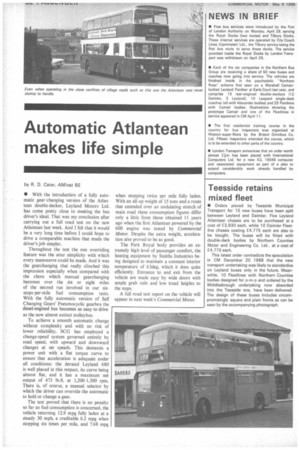Automatic Atlantean makes life simple
Page 34

If you've noticed an error in this article please click here to report it so we can fix it.
by R. D. Cater, AMInst BE
• With the introduction of a fully automatic gear-changing version of the Atlantean double-decker, Leyland Motors Ltd. has come pretty close to meeting the bus driver's ideal. That was my conclusion after carrying out a full road test on the new Atlantean last week. And I felt that it would be a very long time before I could hope to drive a comparable machine that made the driver's job simpler.
Throughout the test the one overriding feature was the utter simplicity with which every manoeuvre could be made. And it was the gearchanging that really clinched this impression especially when compared with the chore which manual gearchanging becomes over the six or eight miles of the second run involved in our sixstops-per-mile fuel consumption tests. With the fully automatic version of Self Changing Gears' Pneumocyclic gearbox the diesel-engined bus becomes as easy to drive as the now almost extinct trolleybus.
To achieve a smooth automatic change without complexity and with no risk of lower reliability, SCG has employed a change-speed system governed entirely by road speed, with upward and downward changes at set speeds. This demands a power unit with a flat torque curve to ensure that acceleration is adequate under all conditions: the derated Leyland 680 is well placed in this respect. its curve being almost flat, and it has a maximum net output of 475 lb.ft. at 1,200-1,300 rpm. There is, of course, a manual selector by which the driver can override the automatic to hold or change a gear.
The test proved that there is no penalty so far as fuel consumption is concerned, the vehicle returning 12.9 mpg fully laden at a steady 30 mph, a creditable 6.2 mpg when stopping six times per mile, and 7.68 mpg
when stopping twice per mile fully laden. With an all-up weight of 15 tons and a route that extended over an undulating stretch of main road these consumption figures differ only a little from those obtained 11 years ago when the first Atlantean powered by the 600 engine was tested by Commercial Motor. Despite the extra weight, acceleration also proved to be as good.
The Park Royal body provides an extremely high level of passenger comfort, the heating equipment by Smiths Industries being designed to maintain a constant interior temperature of 63deg, which it does quite efficiently. Entrance to and exit from the vehicle are made easy by wide doors with ample grab rails and low tread heights to the steps.
A full road test report on the vehicle will appear in next week's Commercial Motor.


















































































































